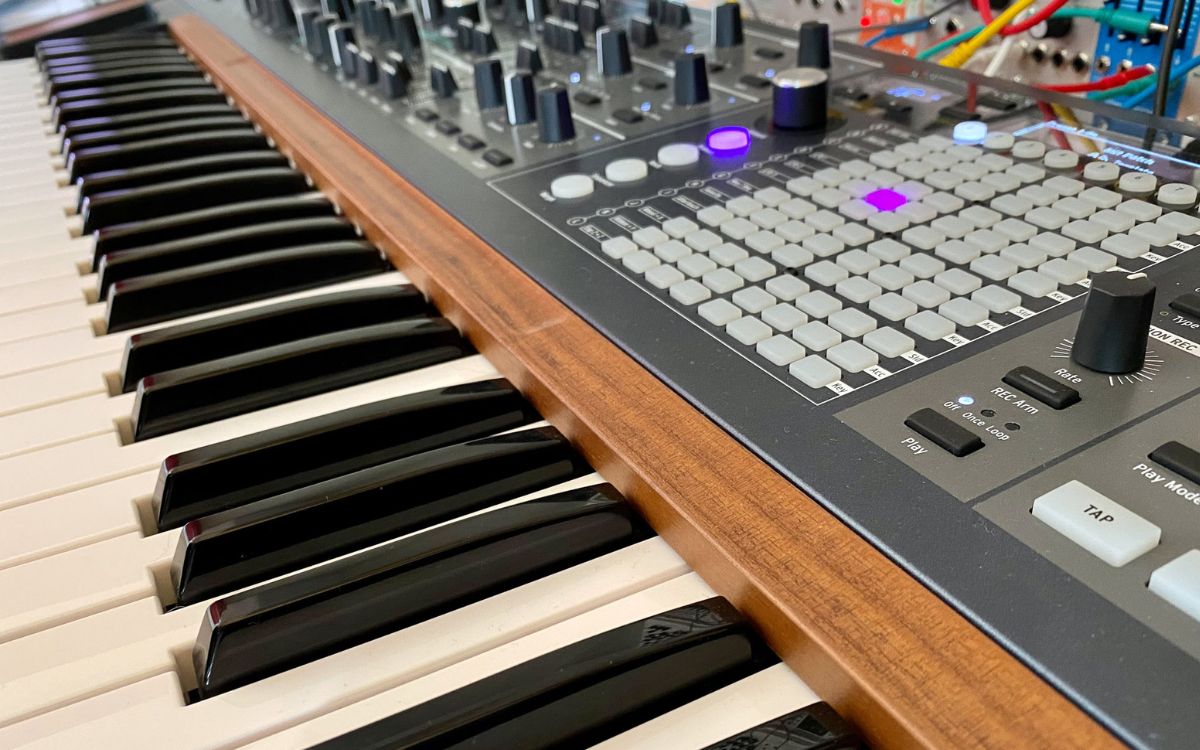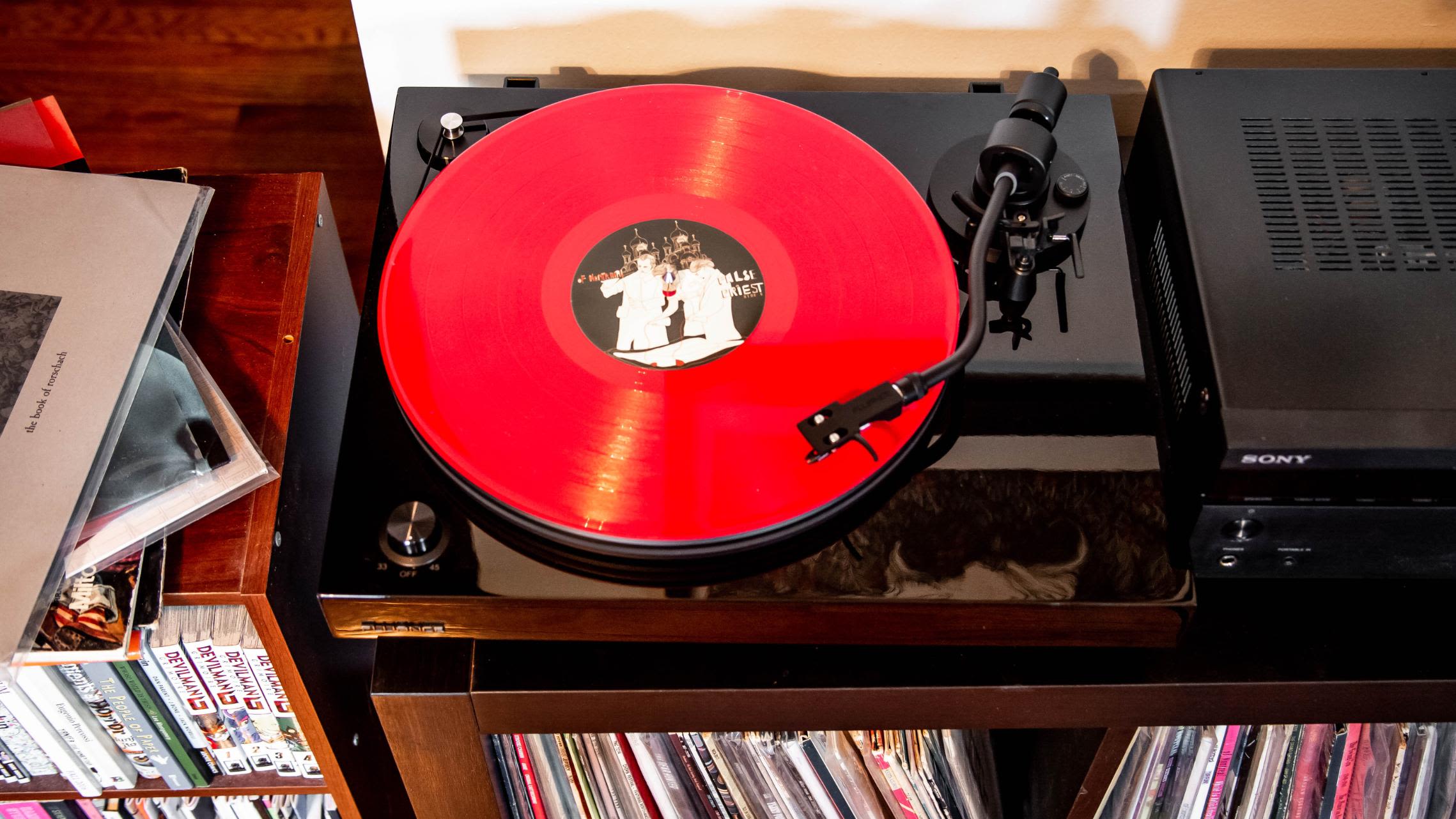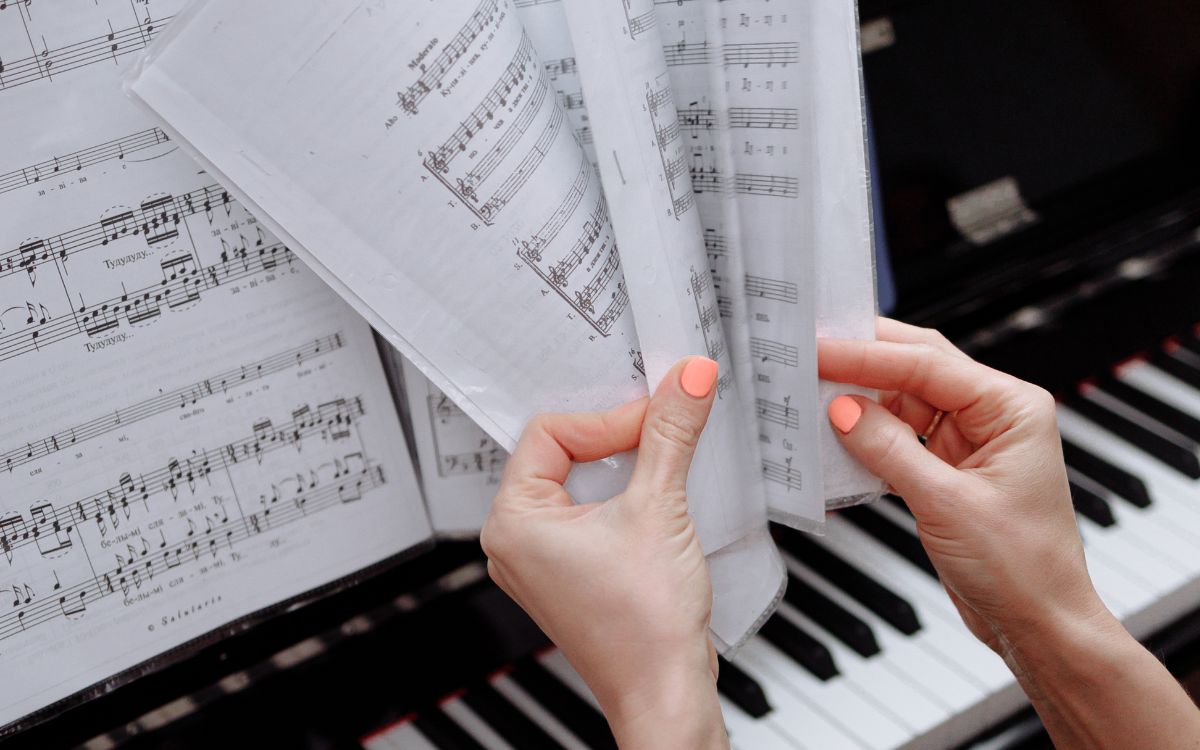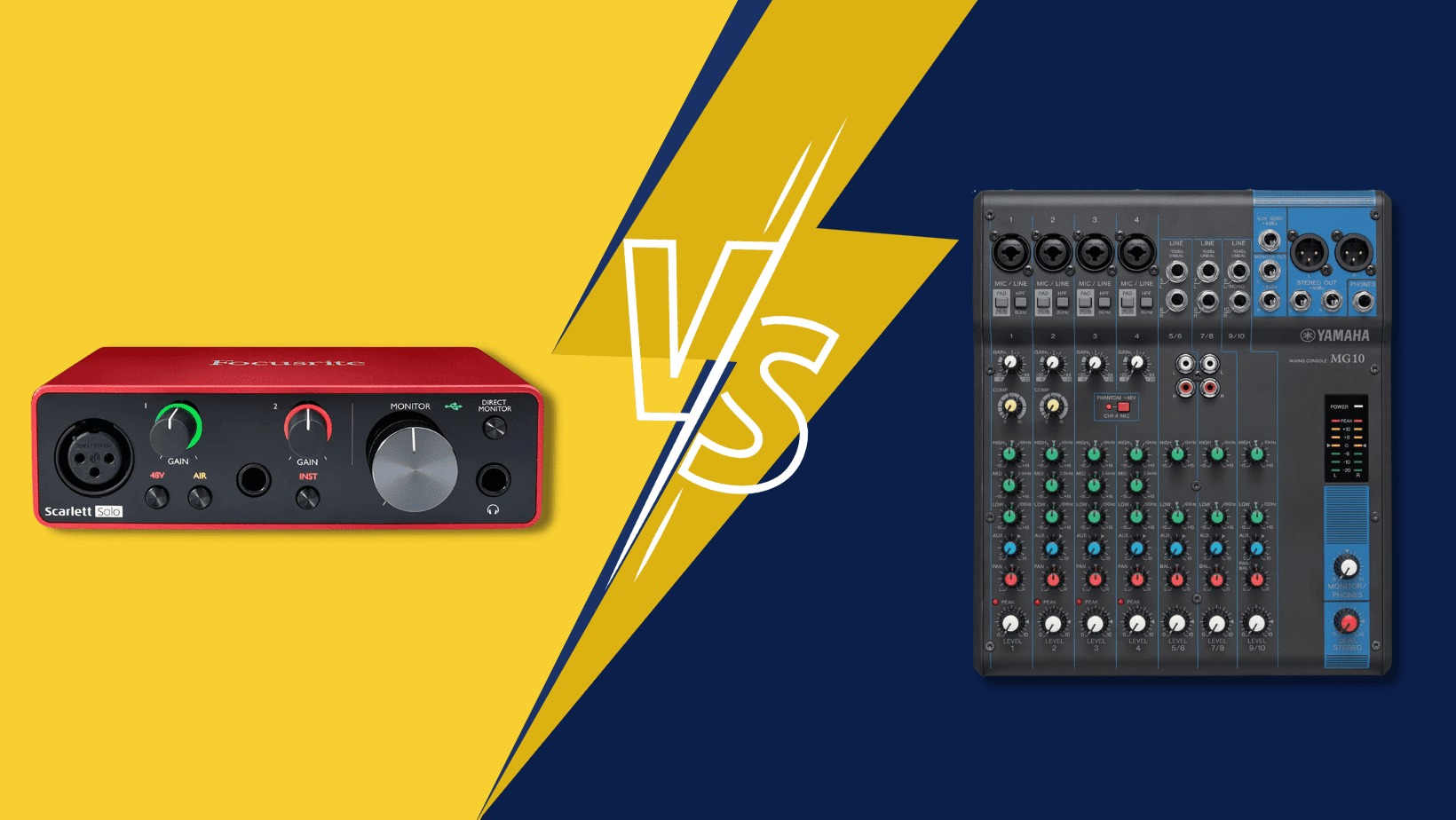Home>Instruments>Synthesizer>What Is The Difference Between A Synthesizer And A Keyboard


Synthesizer
What Is The Difference Between A Synthesizer And A Keyboard
Modified: February 11, 2024
Discover the key differences between a synthesizer and a keyboard. Dive into the world of synths and explore their unique sound design capabilities.
(Many of the links in this article redirect to a specific reviewed product. Your purchase of these products through affiliate links helps to generate commission for AudioLover.com, at no extra cost. Learn more)
Table of Contents
- Introduction
- Definition of a synthesizer
- Definition of a keyboard
- Key components of a synthesizer
- Key components of a keyboard
- Sound generation capabilities of a synthesizer
- Sound generation capabilities of a keyboard
- Control options of a synthesizer
- Control options of a keyboard
- Application and versatility of a synthesizer
- Application and versatility of a keyboard
- Price range and availability of synthesizers
- Price range and availability of keyboards
- Conclusion
Introduction
Welcome to the world of music technology! If you’re a music enthusiast exploring various instruments, you may have come across the terms “synthesizer” and “keyboard.” These two terms are often used interchangeably, causing confusion about their actual differences.
In this article, we will dive into the world of synthesizers and keyboards, uncovering their unique characteristics, capabilities, and applications. By understanding the distinctions between these two instruments, you’ll be able to make an informed decision when it comes to choosing the right tool for your musical journey.
A synthesizer, in essence, is an electronic instrument that generates and manipulates audio signals to produce a wide range of sounds. Unlike traditional instruments that rely on physical vibrations (such as strings or reeds), a synthesizer uses electrical signals to create and shape sounds. With a wide array of sound generation techniques and control options, synthesizers offer musicians limitless possibilities for creativity and experimentation.
On the other hand, a keyboard is a musical instrument that features a set of keys arranged in a specific pattern. Keyboards can be acoustic, such as pianos and organs, or electronic, incorporating various digital technologies. While keyboards can also produce a diverse range of sounds, their primary function is to provide a tangible interface for playing different notes and chords.
Now that we have a general understanding of what synthesizers and keyboards are, let’s delve deeper into their key components, sound generation capabilities, control options, application versatility, and more. By examining these aspects, we will gain a clearer understanding of the unique features that set synthesizers and keyboards apart.
Definition of a synthesizer
A synthesizer is an electronic musical instrument that generates and alters audio signals to produce sounds. Unlike traditional instruments like guitars or pianos that produce sound through physical vibrations, synthesizers rely on electrical signals and circuitry to create and manipulate sound waves.
At its core, a synthesizer consists of several critical components that work together to shape and mold sound. These components include oscillators, filters, amplifiers, and envelopes. Let’s take a closer look at each of these elements:
- Oscillators: Oscillators are responsible for generating sound waves. They produce electrical signals at various frequencies, which determine the pitch or tone of the sound. Synthesizers often feature multiple oscillators that can be tuned and adjusted to create complex and layered sounds.
- Filters: Filters are used to modify the harmonic content of sound waves. They allow certain frequencies to pass through while attenuating or removing others. Filters play a crucial role in shaping the timbre or character of the sound produced by a synthesizer.
- Amplifiers: Amplifiers control the volume or intensity of the sound. They boost or attenuate the electrical signal from the oscillators before it gets sent to the output. With adjustable envelopes, amplifiers can shape the attack, decay, sustain, and release of the sound, creating dynamic and expressive tones.
- Envelopes: Envelopes control how the sound changes over time. They consist of four stages: attack, decay, sustain, and release. The attack determines how quickly the sound reaches its maximum level, the decay controls the rate of volume reduction after the attack, the sustain maintains a steady level, and the release determines how quickly the sound fades away after releasing the keys.
Combined, these components give synthesizers the ability to create a vast range of sounds, from simple tones to complex textures and atmospheric effects. By manipulating parameters such as waveform shape, filter cutoff, envelope settings, and modulation options, musicians can sculpt unique and innovative sounds that go beyond the limitations of traditional instruments.
It’s important to note that synthesizers come in various forms and sizes. They can range from physical, hardware units with built-in keyboards and controls to software-based synthesizers that run on computer systems or mobile devices. These different forms offer musicians flexibility in terms of portability, accessibility, and customization.
Now that we have a better understanding of what a synthesizer is and its fundamental components, let’s explore the definition of a keyboard and how it differs from a synthesizer.
Definition of a keyboard
A keyboard, in the context of musical instruments, refers to a set of keys arranged in a specific pattern that allows musicians to play different notes and chords. Keyboards can be found in a variety of instruments, including pianos, organs, electronic keyboards, and synthesizers.
While synthesizers focus on sound generation and manipulation, keyboards primarily serve as a tactile interface for playing music. The keys on a keyboard are designed to correspond to specific pitches or notes, allowing musicians to produce melodies, harmonies, and rhythms.
Historically, keyboards were initially associated with acoustic instruments such as pianos and organs. These keyboards were mechanical in nature, with each key connected to a physical mechanism that would strike a string or activate an organ pipe to produce sound. The piano, for example, uses hammers to strike strings, while organs use air passing through pipes.
However, with advancements in technology, keyboards have evolved to include electronic components. In electronic keyboards and digital pianos, the keys are typically connected to electronic sensors that detect when they are pressed. These sensors then convert the keypress into an electrical signal that triggers the corresponding sound in the instrument’s internal sound engine.
Unlike synthesizers, keyboards generally have a fixed set of sounds or presets that are built-in or available through various sound libraries. While some keyboards may offer limited sound editing capabilities, their main focus is on offering a wide range of traditional instrument sounds such as piano, organ, strings, and brass.
Keyboards also feature additional controls and functionalities to enhance performance. These can include pitch bend wheels, modulation wheels, assignable knobs and sliders, buttons for octave shifting, and sustain pedals. These controls provide musicians with more expressive possibilities and allow them to shape their performance beyond simply playing the keys.
It’s worth noting that keyboards can also be found as part of synthesizers. Many synthesizers include a built-in keyboard for direct control over the instrument’s sound generation and manipulation. In these cases, the keyboard acts as a means to play the synthesizer, utilizing the various synthesis techniques and control options available.
In summary, a keyboard is a musical interface consisting of keys that musicians use to play notes and chords. While it can be found in various instruments, keyboards standalone as electronic keyboards and digital pianos, offering a wide range of traditional instrument sounds and additional performance controls.
Now that we have explored the definitions of both synthesizers and keyboards, let’s move on to understanding the key components and sound generation capabilities of each.
Key components of a synthesizer
A synthesizer is a complex electronic instrument that encompasses several key components, each playing a vital role in sound generation and manipulation. Let’s break down these components and understand their functions:
- Oscillators: Oscillators are at the heart of a synthesizer. They generate basic sound waves, such as sine, sawtooth, triangle, and square waves. By selecting different waveforms and adjusting parameters like pitch, octave, and detuning, synthesists can create a variety of tones and timbres.
- Filters: Filters shape the frequency content of the sound generated by the oscillators. They allow only certain frequencies to pass through while attenuating or removing others. Common filter types in synthesizers include low-pass, high-pass, band-pass, and notch filters. By adjusting filter parameters like cutoff frequency and resonance, musicians can sculpt the character and tonal qualities of the sound.
- Amplifiers and Envelopes: Amplifiers control the volume of the sound produced by the synthesizer. Envelopes shape the amplitude of the sound over time, controlling parameters like attack, decay, sustain, and release. By manipulating envelope parameters, musicians can create dynamic and expressive sounds with precise control over volume and modulation.
- LFO (Low-Frequency Oscillator): LFOs generate waveforms at a much slower rate than the audio range. They are commonly used to modulate various parameters in the synthesizer, such as oscillator pitch, filter cutoff, or volume. LFO modulation adds movement, vibrato, and rhythmic variations to the sound, allowing for evolving and shifting textures.
- Modulation Sources and Destinations: Synthesizers provide a range of modulation options to create complex and evolving sounds. Modulation sources can include envelopes, LFOs, and even external controllers, while modulation destinations can be any parameter within the synthesizer that can be affected by the modulation source. These modulation capabilities allow for extensive sound shaping and manipulation.
- Effects: Many synthesizers include built-in effects processors that can further enhance the sonic possibilities. Effects such as reverb, delay, chorus, and distortion can be applied to the synthesized sound, adding depth, character, and texture to the overall output.
These components, along with various other features like sequencers, arpeggiators, and polyphony, make synthesizers incredibly versatile and flexible instruments. Musicians can create a wide range of sounds, from simple and traditional instrument emulations to complex, otherworldly textures and experimental sonic landscapes.
It’s important to note that the specific components and features of a synthesizer can vary greatly depending on the model and type of synthesizer. Some synthesizers may have a more simplified architecture for beginners, while others offer advanced synthesis techniques and extensive programming capabilities for professional musicians and sound designers.
Now that we have explored the essential components of a synthesizer, let’s move on to understanding the key components of a keyboard and how they differ from synthesizers.
Key components of a keyboard
A keyboard, whether it’s a standalone electronic keyboard or part of an instrument like a piano or organ, consists of several key components that enable musicians to play different notes and chords. Let’s explore these components in more detail:
- Keys: The keys are the most prominent component of a keyboard. They are arranged in a specific pattern and correspond to specific pitches or notes. When a key is pressed, it triggers a mechanism that creates the sound associated with that note. The number of keys on a keyboard can vary, with some instruments having 61, 76, or 88 keys.
- Sensors and Contact Mechanism: In electronic keyboards, each key is connected to a sensor or switch mechanism that detects when the key is pressed. This sensor sends a signal to the instrument’s sound engine, triggering the corresponding sound. The sensitivity of these sensors can vary, allowing for different levels of expressiveness based on how hard or soft the keys are played.
- Sound Engine: The sound engine is the electronic component responsible for producing the sounds in a keyboard. It can be an internal processor or a combination of hardware and software. The sound engine includes a collection of pre-recorded samples or synthesis algorithms that generate a wide range of sounds, from realistic instrument emulations to electronic and synthesized tones.
- Sound Library: Many keyboards come bundled with a sound library that offers a variety of preset sounds or patches. These patches span different instrument types, including pianos, strings, organs, brass, synthesizers, and more. Musicians can select and play these pre-programmed sounds simply by choosing the desired patch.
- Effects: Keyboards often include built-in effects that can be applied to the sound output. These effects can include reverb, chorus, delay, and various modulation effects. They enhance the sound quality and add texture and depth to the audio output.
- Controls and Functions: Keyboards typically feature additional controls and functions to enhance the overall playing experience. These can include pitch bend wheels, modulation wheels, assignable knobs and sliders, buttons for octave shifting, and sustain pedals. These controls provide musicians with more expressive possibilities and nuanced performance techniques.
The key components of a keyboard are designed to facilitate playing various musical arrangements, whether it’s classical piano pieces, jazz improvisations, or pop melodies. With the ability to switch between different sounds and adjust playing parameters, keyboards offer musicians a versatile tool for expressing their musical ideas and creativity.
It’s important to note that while keyboards can produce a wide range of sounds, their primary focus is on providing a playable interface rather than extensive sound design capabilities. Unlike synthesizers, keyboards typically have fixed sounds and limited customization options, with a stronger emphasis on traditional instrument emulations and ready-to-play presets.
Now that we have explored the key components of both synthesizers and keyboards, let’s delve deeper into their respective sound generation capabilities and the control options they offer musicians.
Sound generation capabilities of a synthesizer
One of the key strengths of a synthesizer is its powerful and versatile sound generation capabilities. Synthesizers offer musicians a wide range of options to create and shape sounds, allowing for endless sonic possibilities. Let’s explore the sound generation capabilities of a synthesizer:
- Oscillators and Waveforms: Synthesizers typically feature multiple oscillators that generate different types of waveforms, such as sine, sawtooth, square, and triangle waves. These waveforms serve as the foundation for creating different tones and timbres. Musicians can adjust parameters like pitch, detuning, and waveform shape to create simple or complex harmonic structures.
- Modulation and LFOs: Synthesizers often come equipped with dedicated Low-Frequency Oscillators (LFOs) that can modulate various parameters. By using LFOs, musicians can apply vibrato, tremolo, or rhythmic variations to parameters like pitch, filter cutoff, or amplitude. This modulation adds movement and interest to the sound, allowing for evolving textures and dynamic effects.
- Filters and Sound Shaping: The inclusion of filters in synthesizers enables precise control over the timbre and character of the sound. Filters can be used to emphasize or attenuate specific frequencies, resulting in a wide range of tonal variations. By adjusting parameters like cutoff frequency and resonance, musicians can sculpt the sound and create drastic changes in its overall character.
- Envelopes and Dynamics: Synthesizers provide envelope generators, which allow musicians to shape the amplitude and dynamics of the sound over time. By manipulating envelope parameters like attack, decay, sustain, and release, musicians can create expressive and evolving soundscapes. Envelope control is essential for producing realistic sounds, such as emulating the nuanced attack of a piano or the subtle fade of a violin note.
- Sampling and Sampling Oscillators: Some modern synthesizers incorporate sampling capabilities, allowing musicians to import and manipulate their own audio samples. This expands the sonic possibilities of a synthesizer, enabling the recreation of real-world sounds, textures, and even vocals. Sampling oscillators provide the means to trigger and manipulate these audio samples within the synthesizer’s sound engine.
- Combination and Layering: Many synthesizers offer the ability to combine multiple oscillators, filters, and modulation options. This allows musicians to layer different sounds together, creating rich and complex textures. By combining different elements, musicians can achieve more expansive and diverse sonic landscapes.
- Real-Time Control: Synthesizers often provide real-time control options, such as performance-oriented knobs, sliders, and assignable controllers. These controls enable musicians to adjust parameters on the fly, allowing for expressive and dynamic performances. Additionally, synthesizers may offer MIDI compatibility, allowing for external control and integration with other MIDI-capable instruments and technologies.
These sound generation capabilities, combined with extensive sound design options, make synthesizers highly flexible and adaptable instruments. They offer musicians the freedom to create unique sounds that extend beyond the limitations of traditional instruments.
It’s worth noting that the sound generation capabilities of a synthesizer can vary depending on its type and complexity. Entry-level synthesizers may offer a more simplified set of features, while advanced modular synthesizers provide endless possibilities for experimentation and customization.
Now that we have a better understanding of the sound generation capabilities of a synthesizer, let’s move on to exploring the sound generation capabilities of a keyboard and how they differ.
Sound generation capabilities of a keyboard
The sound generation capabilities of a keyboard, whether it’s an electronic keyboard or part of an acoustic instrument like a piano or organ, differ from those of a synthesizer. While keyboards primarily focus on playing pre-recorded sounds or emulating traditional instruments, they can still offer some flexibility and creative possibilities. Let’s explore the sound generation capabilities of a keyboard:
- Pre-recorded Sounds and Patches: Keyboards often come equipped with a sound library that includes a wide variety of pre-recorded sounds or patches. These ready-to-play sounds are carefully sampled and selected to offer musicians a range of instrument emulations. Keyboardists can easily switch between different sounds like piano, strings, organ, brass, and more, providing versatility in performance.
- Piano Sampling and Modeling: Many keyboards, especially digital pianos, feature advanced piano sampling or modeling technologies. These technologies aim to recreate the sound and feel of an acoustic piano. With multi-sampled piano recordings or sophisticated modeling algorithms, keyboardists can enjoy authentic piano sounds and realistic playing experiences.
- Layering and Splitting: Keyboards often allow for layering and splitting sounds. Layering enables musicians to combine multiple sounds, such as piano and string layers, creating a fuller and richer sonic texture. Splitting allows keyboardists to assign different sounds to different sections of the keyboard, allowing for dual instrument performances or accompaniment playing.
- Effects Processing: Many keyboards include built-in effects processors. These processors offer a variety of effects like reverb, chorus, delay, and more. These effects enhance the sound quality, adding depth and ambience to the overall audio output. Keyboardists can adjust the effect parameters to achieve the desired sonic result.
- Performance Controls: Keyboards often include performance-oriented controls such as pitch bend wheels, modulation wheels, assignable knobs, sliders, and buttons. These controls allow musicians to add expression and dynamics to their playing, whether it’s through pitch bending, vibrato, or real-time sound modulations. Performance controls enhance the playability and versatility of the keyboard.
- MIDI Connectivity: Keyboards commonly feature MIDI connectivity, allowing them to connect to external devices like computers, sound modules, or other MIDI-capable instruments. This opens up possibilities for further sound generation and control using external software or hardware devices.
While keyboards may not offer the extensive sound manipulation capabilities of a synthesizer, they provide a convenient and accessible way to play a wide range of sounds. Whether it’s performing classical piano pieces, accompanying a band with organ sounds, or adding lush string textures to a composition, keyboards offer musicians a versatile tool for musical expression.
It’s important to note that the sound generation capabilities of a keyboard are dependent on the specific model and type of instrument. Digital keyboards may offer additional features and sound customization options compared to acoustic keyboards, but both provide musicians with valuable tools for musical creativity.
Now that we have explored the sound generation capabilities of both synthesizers and keyboards, let’s delve into the control options available with a synthesizer.
Control options of a synthesizer
Synthesizers offer a wide array of control options that allow musicians to shape and manipulate the sound to their desired outcome. These control options provide a high level of customization and creative freedom. Let’s explore some of the key control options available with a synthesizer:
- Knobs and Sliders: Synthesizers often feature an array of physical knobs and sliders that allow musicians to adjust various parameters in real time. These controls can include cutoff frequency, resonance, envelope settings, LFO rate, and more. By turning knobs or sliding sliders, musicians can instantly modify the sound and create dynamic variations.
- Assignable Controls: Some synthesizers provide assignable knobs, sliders, or buttons that musicians can assign to specific parameters of their choice. This flexibility allows for customized control configurations, tailored to the musician’s preferences and playing style. Assignable controls offer greater versatility in sound manipulation and performance.
- Modulation Wheel and Pitch Bend Wheel: Modulation wheels and pitch bend wheels add expressive capabilities to a synthesizer. The modulation wheel is typically used to modulate parameters like filter cutoff, LFO intensity, or vibrato depth. The pitch bend wheel allows musicians to bend the pitch of notes, adding subtle or dramatic pitch variations for expressive playing.
- Touch-sensitive Keys and Aftertouch: Many advanced synthesizers feature touch-sensitive keys, where the velocity and pressure applied to the keys can affect the sound. Musicians can create dynamic and nuanced performances by varying the force with which they play the keys. Additionally, aftertouch allows for further sound modulation by applying pressure on a sustained key.
- Sequencers and Arpeggiators: Some synthesizers are equipped with built-in sequencers and arpeggiators. Sequencers allow musicians to program and playback sequences of notes, creating complex melodic patterns and rhythmic sequences. Arpeggiators generate arpeggiated patterns based on the chords played, adding rhythmic interest and automatized note combinations.
- External Control and MIDI: Synthesizers often feature MIDI connectivity, allowing them to be controlled by external devices such as MIDI keyboards, controllers, or software applications. This enables musicians to integrate their synthesizer into a larger setup, triggering and manipulating sounds from external sources.
- Patch Memory and Programming: Many synthesizers offer patch memory, allowing musicians to store and recall their custom sound settings. This feature makes it easy to save unique sound designs and access them quickly during performances or studio sessions. Synthesizers with advanced programming capabilities enable musicians to create their own sounds from scratch, deeply exploring the synthesis parameters and making unique creations.
These control options give musicians a high level of expressiveness and control over the sound produced by a synthesizer. By adjusting parameters in real time, experimenting with different combinations, and utilizing performance-oriented controls, musicians can create evolving and personalized sounds that suit their musical vision.
Additionally, the flexibility provided by external control options and MIDI connectivity allows for integration with other instruments and technologies, expanding the creative possibilities even further.
Now that we have explored the control options of a synthesizer, let’s move on to understanding the control options available with a keyboard.
Control options of a keyboard
While keyboards may not offer the same extensive control options as synthesizers, they still provide musicians with several control options to enhance their playing experience and expressiveness. Let’s take a look at some of the key control options available with a keyboard:
- Pitch Bend and Modulation Wheel: Many keyboards feature a pitch bend wheel and a modulation wheel. The pitch bend wheel allows musicians to bend the pitch of notes, adding expressive pitch variations to their playing. The modulation wheel is typically used to apply modulation effects such as vibrato or to control specific parameters like filter cutoff or LFO intensity.
- Assignable Controls: Some keyboards come equipped with assignable knobs, buttons, or sliders that musicians can assign to control various parameters of their choice. These assignable controls offer versatility in sound manipulation and allow for customized control configurations based on personal preferences and playing style.
- Performance Controls: Keyboards often incorporate performance-oriented controls such as octave shift buttons, which allow musicians to reach higher or lower registers on the keyboard. Other performance controls may include pedal inputs for sustain, expression, or other pedal-based effects. These features provide additional control options and enhance the playability of the keyboard.
- Velocity Sensitivity: Keyboards with velocity-sensitive keys respond to the speed or force with which the keys are pressed. By varying the key velocity, musicians can create dynamic and expressive performances, with differences in volume and tonal characteristics based on their playing intensity.
- Split and Layer Functionality: Many keyboards provide split and layer functionality, allowing musicians to split the keyboard into different sections, each assigned to a different sound or instrument. This enables dual-instrument performances or layered combinations of sounds, providing a richer and more versatile playing experience.
- MIDI Connectivity: Keyboards commonly feature MIDI connectivity, enabling them to connect to external devices such as computers, sound modules, or other MIDI-capable instruments. This connectivity opens up possibilities for further control and integration with external software or hardware devices.
- Sound Editing Options: While keyboards may have a more limited range of sound editing options compared to synthesizers, some models do offer basic editing capabilities. Musicians may be able to adjust parameters such as attack, decay, sustain, release, and effects settings for pre-recorded sounds or presets.
These control options, although not as extensive as those of a synthesizer, still provide musicians with the means to add expression and creativity to their performance. Whether it’s through pitch bending, modulation effects, customizable controls, or layered sound combinations, keyboardists can personalize their playing and add their unique touch to the music.
It’s worth noting that the availability and variety of control options can vary depending on the specific model and type of the keyboard. Advanced digital keyboards often offer more control options and customization features compared to basic electronic keyboards or acoustic instruments with built-in keyboards.
Now that we have explored the control options of a keyboard, let’s move on to understanding the applications and versatility of a synthesizer.
Application and versatility of a synthesizer
Synthesizers are incredibly versatile instruments with a wide range of applications in the music industry and beyond. Their extensive sound generation capabilities and flexible control options make them a powerful tool for musicians, sound designers, and producers. Let’s explore the application and versatility of a synthesizer:
- Music Production and Composition: Synthesizers are widely used in music production, allowing composers and producers to create unique sounds and textures for their compositions. From creating lush pad sounds to crafting complex basslines and lead melodies, synthesizers offer limitless possibilities for music creation across various genres.
- Live Performance: Synthesizers are popular among live performers, whether solo artists, bands, or electronic music producers. Their ability to generate diverse and dynamic sounds, combined with real-time control options, enables musicians to deliver captivating and exciting performances on stage.
- Sound Design and Film Scoring: Synthesizers are indispensable in the realm of sound design and film scoring. They can generate unique and otherworldly sound effects, atmospheric textures, and evocative soundscapes. Synthesizers provide the ability to shape and manipulate sounds to perfectly complement visuals and enhance the overall cinematic experience.
- Electronic Dance Music (EDM) and Electronic Genres: Synthesizers are the backbone of electronic music genres such as EDM, techno, house, and trance. Their ability to create pulsating basslines, infectious arpeggios, and intricate sound textures has made them an essential instrument for electronic music producers and DJs.
- Experimental and Avant-Garde Music: Synthesizers are a playground for experimental musicians and those pushing the boundaries of sound. The versatility and flexibility of synthesizers enable musicians to delve into abstract and unconventional sound creations, making them a staple in the world of avant-garde and experimental music.
- Educational and Learning Tools: Synthesizers serve as valuable educational tools, helping students and enthusiasts understand the principles of sound synthesis and electronic music production. The hands-on experience of manipulating various synthesis parameters fosters creativity, exploration, and a deeper understanding of sound design concepts.
- Hardware and Software Integration: Synthesizers can be seamlessly integrated into hardware or software setups, allowing musicians to combine their unique sound generation capabilities with other instruments or recording systems. MIDI compatibility and control options provide a smooth integration process, enabling musicians to create intricate and layered compositions.
The application and versatility of a synthesizer extend far beyond the music industry. They are also used in fields such as advertising, gaming, and multimedia production, where the ability to create custom sounds and audio effects is essential for creating immersive experiences.
With advancements in technology, synthesizers have become more accessible and offer a range of options to cater to different levels of expertise, from entry-level options for beginners to complex modular systems for advanced users. This accessibility ensures that synthesizers can be utilized by a wide range of musicians and creators.
Now that we have explored the application and versatility of a synthesizer, let’s move on to understanding the application and versatility of a keyboard.
Application and versatility of a keyboard
Keyboards, whether electronic or acoustic, possess a versatile and wide range of applications in the music industry and beyond. Their primary function as playable interfaces makes them a fundamental tool for musicians across various genres and settings. Let’s explore the application and versatility of a keyboard:
- Performing Traditional Instruments: Keyboards, especially acoustic ones like pianos and organs, allow musicians to faithfully recreate the sounds and playing techniques of traditional instruments. They serve as a versatile platform for playing classical, jazz, and contemporary music, providing the sound and feel of instruments like grand pianos and pipe organs.
- Contemporary Music Production: Keyboards, both electronic and digital, are essential in contemporary music production. They offer a vast library of pre-recorded sounds and patches, ensuring that musicians can quickly access and integrate various instruments into their compositions. Keyboards provide the capability to create realistic instrument emulations, which are integral to many modern music styles and productions.
- Live Performances: Keyboards are widely used in live performances, ranging from solo piano recitals to full band setups. Their capability to produce a wide range of sounds allows keyboardists to adapt to different musical genres and perform as lead players, accompanists, or even as part of an ensemble. Keyboards provide the versatility to seamlessly switch between different sounds and play expressive performances on stage.
- Recording Studios: Keyboards find extensive utilization in recording studios as essential tools for session musicians and producers. Their ability to cover a wide range of instrument sounds, from pianos to synthesizers, makes them indispensable for creating professional recordings. The flexibility of keyboards enables musicians to compose and record intricate keyboard arrangements with ease.
- Education and Learning: Keyboards play a vital role in music education and learning. Their intuitive layout and tactile interface make them ideal instruments for beginners to start their musical journey. Additionally, keyboard instruction helps students understand musical concepts, theory, and develop skills that can be applied to other instruments as well.
- Worship and Religious Services: Keyboards often have a significant presence in worship and religious services. They provide a versatile range of sounds, allowing keyboardists to accompany choirs, lead congregational singing, and create a harmonious atmosphere for worship gatherings.
- Home and Personal Enjoyment: Keyboards serve as instruments for personal enjoyment and leisure. They can be played in the comfort of one’s home, providing an avenue for relaxation, creativity, and expression. Keyboards enable individuals to explore music and enjoy the pleasure of playing without the need for extensive training or performance obligations.
Keyboards come in various forms, from portable electronic keyboards to acoustic grand pianos, catering to different needs and preferences. Their versatility lies in their ability to offer realistic instrument sounds, adaptability to different musical styles, and accessibility to musicians of all skill levels.
Additionally, modern keyboards often integrate with technology, allowing for connection to computers, music software, and MIDI devices. This integration expands their versatility by offering limitless possibilities for recording, composition, and sound manipulation.
Now that we have explored the application and versatility of a keyboard, let’s move on to understanding the price range and availability of synthesizers.
Price range and availability of synthesizers
The price range and availability of synthesizers vary depending on factors such as brand, model, features, and the type of synthesizer. Synthesizers are available at various price points, catering to different budgets and requirements. Let’s explore the price range and availability of synthesizers:
Entry-level and Affordable Synthesizers: There are a variety of entry-level and affordable synthesizers available in the market, designed for beginners and those on a limited budget. These synthesizers often offer basic sound generation capabilities, a smaller number of controls, and preset sounds. They serve as a great starting point for musicians looking to explore the world of synthesizers without breaking the bank.
Mid-range Synthesizers: Mid-range synthesizers provide a balance between affordability and expanded features. They typically offer a wider range of sound generation options, advanced control capabilities, and enhanced sound quality. These synthesizers are suitable for intermediate musicians and those seeking more diverse sonic possibilities.
High-end and Professional Synthesizers: High-end synthesizers are designed for professional musicians, sound designers, or those with specific needs for complex sound manipulation. These synthesizers often include advanced synthesis techniques, extensive control options, and premium build quality. They offer unparalleled sound quality, flexibility, and customization. High-end synthesizers might come in the form of standalone hardware units or modular systems.
Synthesizers can be obtained through various channels:
- Music Retailers: Synthesizers are available in dedicated music stores, both physical locations and online. Music retailers offer a range of brands and models, allowing musicians to try out different synthesizers before making a purchase. They often provide expert advice and assistance to help musicians find the synthesizer that meets their needs.
- Online Marketplaces: Online marketplaces like Amazon, eBay, and specialized music equipment websites offer a vast selection of new and used synthesizers. These platforms provide convenient access to a wide variety of brands and models, along with customer reviews and price comparisons.
- Direct from Manufacturers: Many manufacturers sell synthesizers directly through their own websites. This ensures authenticity and offers direct access to the latest models, manufacturer support, and warranty options.
- Second-Hand Market: Buying from the second-hand market is an option for those looking for more affordable synthesizers. Websites, forums, and classified ads are popular sources for purchasing used synthesizers. However, caution should be exercised when purchasing second-hand to ensure the condition and authenticity of the item.
It’s worth noting that while the entry-level and mid-range synthesizers are more widely available, high-end synthesizers or rare vintage models may have limited availability and may require more dedicated searching or specialized shops.
Ultimately, the price range and availability of synthesizers provide musicians with a range of options to suit their budget, experience level, and specific requirements. Whether you’re a beginner or a seasoned professional, there is likely a synthesizer available that aligns with your musical aspirations and financial considerations.
Now that we have explored the price range and availability of synthesizers, let’s move on to understanding the price range and availability of keyboards.
Price range and availability of keyboards
Keyboards, whether acoustic or electronic, are available in a wide range of price points, making them accessible to musicians with varying budgets and needs. The price range of keyboards depends on factors such as brand reputation, quality of construction, features, and the type of keyboard. Let’s explore the price range and availability of keyboards:
Entry-level and Affordable Keyboards: Entry-level keyboards are designed for beginners or those on a limited budget. These keyboards usually have a lower price point and offer basic functionality and features. They serve as a great starting point for learning and practice, providing essential playing capabilities and introductory sound options.
Mid-range Keyboards: Mid-range keyboards expand on the features and capabilities offered by entry-level options. These keyboards usually offer better sound quality, a wider range of built-in sounds and effects, and additional control options. They cater to intermediate-level musicians who want more versatility and customization in their performances.
High-end and Professional Keyboards: High-end keyboards are designed for experienced musicians, professional performers, and those seeking advanced features and craftsmanship. These keyboards often provide top-of-the-line sound quality, realistic instrument emulations, extensive control options, and premium build quality. They offer an exceptional playing experience and a wide range of sophisticated features suitable for professional use.
The availability of keyboards is widespread, with different channels offering access to a variety of options:
- Music Retailers: Keyboard instruments are readily available in dedicated music stores, both physical locations and online. These retailers offer a range of brands and models, allowing musicians to try out different keyboards and receive expert guidance to find the instrument that suits them best.
- Online Marketplaces: Online platforms like Amazon, eBay, and specialized music equipment websites provide a vast selection of new and used keyboards. These marketplaces offer convenience, extensive options, customer reviews, and often competitive pricing.
- Direct from Manufacturers: Many keyboard manufacturers sell their instruments directly through their own websites. This provides musicians with direct access to the latest models, warranty options, and support straight from the source.
- Second-Hand Market: Purchasing from the second-hand market is an option for those seeking more affordable keyboards. Second-hand keyboards can be found on various websites, forums, and classified ads. As with any used instrument, careful consideration should be given to evaluate the condition and authenticity before making a purchase.
Keyboards are widely available, ranging from portable electronic keyboards to acoustic grand pianos. The availability of different price points and models ensures that musicians of all backgrounds and skill levels can find a keyboard that fits their needs and budget.
Keep in mind that high-end or rare vintage keyboards may have limited availability and might require more dedicated searching or accessing specialized resellers or vintage instrument dealers.
Now that we have explored the price range and availability of keyboards, let’s conclude our discussion.
Conclusion
In conclusion, synthesizers and keyboards are distinct instruments with their own unique characteristics, applications, and capabilities. Synthesizers excel in sound generation and manipulation, offering a wide range of customizable sounds, advanced control options, and the ability to create unique and innovative textures. Keyboards, on the other hand, prioritize playability and versatility, providing musicians with a tangible interface to play different notes and chords, along with a diverse library of pre-recorded sounds and instrument emulations.
Synthesizers find their place in music production, live performances, sound design, and experimental music, where their extensive sound generation capabilities and flexibility enable musicians to explore new sonic territories. Keyboards, with their wide range of applications, are ideal for performing traditional instruments, contemporary music production, educational purposes, and worship services, offering musicians a versatile tool for musical expression and enjoyment.
When considering a synthesizer or keyboard, it is essential to evaluate factors such as the key components, sound generation capabilities, control options, and the specific needs and budget of the musician. Understanding the distinctions between these instruments helps musicians make an informed decision based on their artistic vision and desired sound palette.
Whether a musician is looking for a synthesizer to create unique and experimental sounds or a keyboard to faithfully replicate traditional instrument tones or provide a wide range of playing options, there are options available at various price points and through different distribution channels. Music retailers, online marketplaces, direct manufacturer purchases, and the second-hand market offer access to a variety of models to suit different preferences and budgets.
In the end, both synthesizers and keyboards play integral roles in the music landscape, offering musicians endless possibilities for creativity, expression, and musical exploration. Whether you find yourself drawn to the boundless sonic potential of a synthesizer or the versatility and playability of a keyboard, both instruments have their place in the rich tapestry of music-making.











